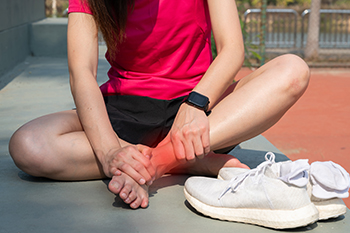Freehold (732) 294-9393
Freehold (732) 294-9393

Plantar fasciitis, an inflammation of the tissue that runs along the bottom of the foot, is one of the most common sources of foot and heel pain. One symptom of this condition is feeling pain after a period of rest, such as sleeping or a long car ride. Pain in the arch of the foot, swollen heels, and persistent heel pain are other symptoms. About 80 percent of people who have plantar fasciitis can also experience tightness in the Achilles tendon at the back of the heel. Furthermore, plantar fasciitis may affect the toes, ankles, and calf muscles, but these symptoms can be indirect results of the inflammation of the plantar fascia ligament. Active men and women between the ages of 40 and 70 are more at risk of developing plantar fasciitis. Taking certain medications, performing stretching exercises, and making changes to activity levels are believed to be helpful in relieving the pain of plantar fasciitis. If you need help with managing this condition, it is suggested that you make an appointment with a podiatrist for a diagnosis and appropriate treatment options.
Plantar fasciitis can be very painful and inconvenient. If you are experiencing heel pain or symptoms of plantar fasciitis, contact Dr. Henry Miller from New Jersey. Our doctor can provide the care you need to keep you pain-free and on your feet.
What Is Plantar Fasciitis?
Plantar fasciitis is the inflammation of the thick band of tissue that runs along the bottom of your foot, known as the plantar fascia, and causes mild to severe heel pain.
What Causes Plantar Fasciitis?
How Can It Be Treated?
While very treatable, plantar fasciitis is definitely not something that should be ignored. Especially in severe cases, speaking to your doctor right away is highly recommended to avoid complications and severe heel pain. Your podiatrist can work with you to provide the appropriate treatment options tailored to your condition.
If you have any questions please feel free to contact our office located in Freehold, NJ . We offer the newest diagnostic and treatment technologies for all your foot and ankle needs.

Sprains are one of the most common ankle injuries, especially affecting athletes and people who are otherwise physically active. The majority of these injuries involve a lateral ligament in the ankle joint and are caused by the foot rolling over and a ligament overstretching. Another, more serious, ankle sprain is termed a syndesmotic, or high ankle, sprain. This involves the tissue in the front of the ankle, called the anterior tibiofibular ligament. Such an injury makes it impossible to walk or flex the foot and is extremely painful. In most cases, surgery is the only option for treatment and can involve months of staying off the injured foot. One of the main risks of incurring a syndesmotic ankle sprain is participating in high-impact sports such as soccer, basketball, tennis, and trail running. Other risks include having had a previous ankle sprain, being obese, and starting a sports activity after being sedentary for a long time. If you have such an ankle sprain, it is suggested that you visit a podiatrist who will examine the joint, conduct multiple tests, and offer appropriate treatment options.
Although ankle sprains are common, they aren’t always minor injuries. If you need your ankle injury looked at, contact Dr. Henry Miller from New Jersey. Our doctor can provide the care you need to keep you pain-free and on your feet.
How Does an Ankle Sprain Occur?
Ankle sprains are the result of a tear in the ligaments within the ankle. These injuries may happen when you make a rapid shifting movement while your foot is planted. A less common way to sprain your ankle is when your ankle rolls inward while your foot turns outward.
What Are the Symptoms?
Preventing a Sprain
Treatment of a Sprain
In many cases, the RICE method (Rest, Ice, Compression, and Elevate) is used to treat ankle sprains. However, you should see a podiatrist to see which treatment option would work best with your injury. In severe cases, surgery may be required.
It is important to ask your doctor about rehab options after you receive treatment for your injury. Stretching, strength training, and balance exercises may help the ankle heal while also preventing further injury.
If you have any questions, please feel free to contact our office located in Freehold, NJ . We offer the newest diagnostic and treatment technologies for all your foot care needs.

Both running and walking can be beneficial to your health. Running is an aerobic activity that assists with strengthening muscles and bones, in addition to improving heart function. Walking engages the legs and core while helping to alleviate stress, enhancing cardiovascular health and overall fitness. Whether you walk or run, you may want to consider getting athletic shoes that match the activity. Doing so can ensure a more efficient workout and lessen injuries. The shoes for these two activities are different because of the various ways the feet strike the ground and the amount of force sustained by the feet. While running, you may have both feet off the ground at once, while when walking, one foot is always on the ground. Both exercisers land on their heels first, but walkers roll forward onto their toes immediately. Runners distribute more body weight across their feet than walkers. Shoes for running and walking are made to manage these different movements. If you enjoy walking or running and want to make sure your shoes are serving you well, it is suggested that you consult with a podiatrist.
For more information about walking shoes versus running shoes, consult with Dr. Henry Miller from New Jersey. Our doctor can measure your feet to determine what your needs are and help you find an appropriate pair of footwear.
Foot Health: The Differences between Walking & Running Shoes
There are great ways to stay in shape: running and walking are two great exercises to a healthy lifestyle. It is important to know that running shoes and walking shoes are not interchangeable. There is a key difference on how the feet hit the ground when someone is running or walking. This is why one should be aware that a shoe is designed differently for each activity.
You may be asking yourself what the real differences are between walking and running shoes and the answers may shock you.
Differences
Walking doesn’t involve as much stress or impact on the feet as running does. However, this doesn’t mean that you should be any less prepared. When you’re walking, you land on your heels and have your foot roll forward. This rolling motion requires additional support to the feet.
Flexibility – Walking shoes are designed to have soft, flexible soles. This allows the walker to push off easily with each step.
If you have any questions, please feel free to contact our office located in Freehold, NJ . We offer the newest diagnostic and treatment technologies for all your foot care needs.

We learn to walk at an early age, putting one foot in front of the other to get somewhere else. Unless you are on a trail or other uneven surface, most people have a smooth and even gait. When this normal pattern changes and the walking is less steady, it may be a sign of a problem termed ataxic gait. Symptoms include dizziness or vertigo, shuffling, loss of balance, and stumbling. Among the causes of an unsteady gait are cardiovascular disease, musculoskeletal or neurological disorders, infections, or certain medications. Someone with an unsteady gait may exhibit changes, such as standing or walking with the feet wider apart, walking more slowly, or falling more often. If you notice such changes in behavior around walking, it is suggested that you make an appointment with a podiatrist for a gait evaluation. You may be asked to walk toe to heel, and your stance, step length, and balance will be noted. At that point, the podiatrist can recommend the proper course of action for you to take to address the problem of an unsteady gait.
If you have any concerns about your feet, contact Dr. Henry Miller from New Jersey. Our doctor can provide the care you need to keep you pain-free and on your feet.
Biomechanics in Podiatry
Podiatric biomechanics is a particular sector of specialty podiatry with licensed practitioners who are trained to diagnose and treat conditions affecting the foot, ankle and lower leg. Biomechanics deals with the forces that act against the body, causing an interference with the biological structures. It focuses on the movement of the ankle, the foot and the forces that interact with them.
A History of Biomechanics
Modern technological improvements are based on past theories and therapeutic processes that provide a better understanding of podiatric concepts for biomechanics. Computers can provide accurate information about the forces and patterns of the feet and lower legs.
Understanding biomechanics of the feet can help improve and eliminate pain, stopping further stress to the foot.
If you have any questions please feel free to contact our office located in Freehold, NJ . We offer the newest diagnostic and treatment technologies for all your foot and ankle needs.